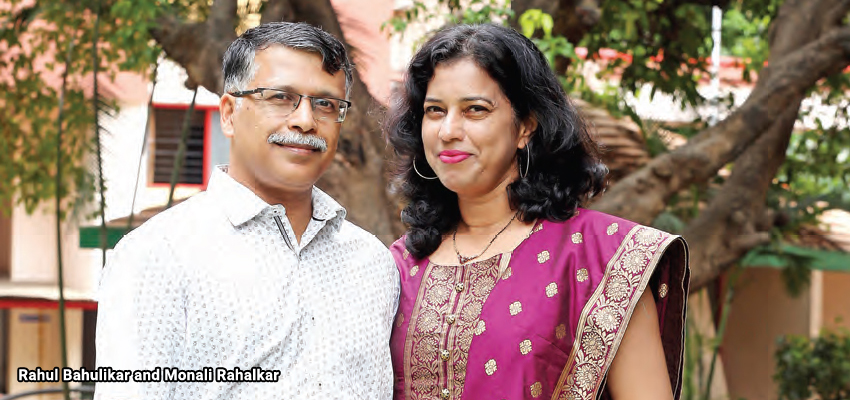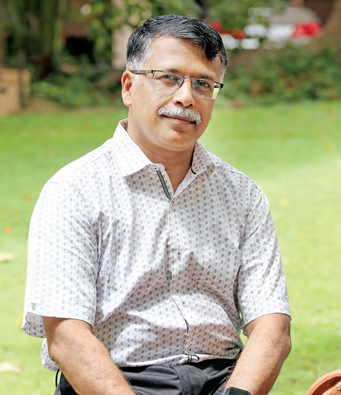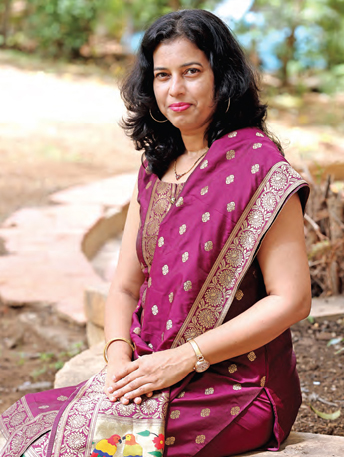In quest of the full truth behind Covid

It’s evidence that goes well beyond theories. It’s a solid, carefully built hypothesis that global powers-including the US and World Health Organisation (WHO)-may ignore at their own peril: the likelihood that COVID-19 or SARS-CoV-2 originated from a lab in Wuhan rather than a seafood market as China had controversially claimed. And to think, it’s two members of India’s very own scientific community who have put forth a theory that may not be dismissed as a conspiratorial fantasy. If anything, the work put in by Indian scientist couple, Dr. Rahul Bahulikar and Dr. Monali Rahalkar, along with 26 other scientists the world over, proves a fundamental point: Unlike fiction, non-fiction need not be palpable. While Monali is employed at Pune’s premier Agharkar Research Institute, Rahul works at the BAIF Development Research Foundation.
Corporate Citizen gets up and close with the dynamic duo, on what keeps them going.
Dr. Rahul Bahulikar and Dr. Monali Rahalkar’s work came into the spotlight in June 2021, at the time when the US President Joe Biden had ordered a ninety days probe into the origins of COVID-19, including the possibility that it had leaked from a lab. The quest for the origin of the catastrophe, one that changed the world in myriad ways- forever, was their goal. The scientist duo had joined the team of international scientists, and scholars, who have been writing open letters to the various powers including the WHO for a transparent investigation of the origins of the pandemic virus. In a major success for the scientists, WHO has recently conceded the need for a probe as well as the possibility of a lab leak (through its Sago report, dated June 9, 2022).
"I was an average student; I took up science because that was the thing to do. In the First year of BSc, I began trekking, which made me fall in love with nature and plants. That’s how I ended up taking to pursuing botany"
- Rahul Bahulikar
Corporate Citizen: Both of you are India’s pride, leading the quest for some truly necessary answers with regard to Covid. Lets’ start from the beginning. How did you get into scientific research? Was it a passion from the start or did you stumble into it?

Monali Rahalkar: I studied at Pune’s Jnana Prabodhini school, an old and much respected school with a strong focus on encouraging those who are good at academics. While I have always loved science, I also loved the arts, particularly literature and poetry. I have always been someone who has enjoyed the freedom and expression of well-chosen words. So that kind of led to a dilemma: what career to take up and why. My brother suggested I go for science as that needed solid guidance; besides, who was to stop me from pursuing the poetry and art I loved informally? So that settled it! Science it was! While I wanted to study Ayurveda and pursue a BAMS degree, I developed chicken pox in my XIIth and scored a little less than what I thought I would. That’s how I ended up taking up microbiology-which I enjoyed thoroughly.
Rahul Bahulikar: I was an average student; I took up science because that was the thing to do! However, it was in the First year of BSc that I began trekking and outdoor activities that made me fall in love with nature and plants. That’s how I ended up taking pursuing botany.
CC: How did the two of you meet? And was it the proverbial love at first sight or was it a gradual development of friendship?
Rahul Bahulikar: No, it was not love at first sight. Rather a bond that developed over time. We met at the NCL in the late 90s as part of a biodiversity project.
CC: Obviously, the question that everyone wants answers to regarding the Covid crisis is quite simply this: was it deliberate and man-made?
Monali Rahalkar: I think that even if there is a strong possibility that the virus could have leaked from a lab, it was not deliberate, but could have been more like a research-related accident. Though the virus shows some features which reflect that it could have been engineered, we don’t think that the release of the virus was deliberate.
CC: Please share the details of your research thus far. How and when did you start on it?
Rahul Bahulikar: Our work started in the early days of the crisis- March-April 2020, to be precise. We discovered that the Wuhan Institute of Virology had collected a relative of the SARS-CoV-2, RaTG13, a SARS-like coronavirus, from a mineshaft in Moijang in the Yunnan province of South China. The mineshaft which happened to be full of bats left six miners hired to clean the fecal matter infected with a pneumonia-like illness showing symptoms matching today’s COVID-19.
When we first published the connection between pneumonia in miners in 2012 and the RaTG13 being from the same mine, as a pre-print, we were contacted by a Twitter user named SEEKER, part of a group called DRASTIC. This Twitter group had the goal of digging deeper into the origins of SARS-CoV-2 including the possibility of a lab leak. SEEKER has a unique specialty: finding hidden research material and basic knowledge of Mandarin. The Master’s thesis shared by him was in the Chinese language, but a deep dive into the thesis showed that the miner’s disease was very similar to that of COVID-19.
So, one would think this is how it all started. However, there were no cases in Yunnan or China between 2012-2019. Several bat fecal samples containing coronaviruses were brought from this mine to the Wuhan Institute of Virology-WIV, the premier institute which houses thousands of such samples. Later, we found that they sequenced RaTG13 in 2018 and we do not know what they further did with the sequence. However, WIV had developed techniques to build chimeric viruses or could synthesize viruses from sequence information, and this could be the reason that we and many others suspect SARS-CoV-2 could be a product of such genetic engineering or serial passage on a backbone virus. Despite the clues, the smoking gun is still not found. For irrefutable facts, the scientific community would need both on-site and off-site lab records as well as details of the experiments they carried out. However, many circumstantial pieces of evidence indicate that the lab leak theory looks more plausible.
CC: If the lab leak theory is proved beyond doubt, won’t it have a major impact on the way virology labs work?
Monali Rahalkar: Absolutely, for sure. Things would change, the rules would be reworked, and there would be more restrictions and increase in lab safety and security. Even if there is no clear answer for the origin question today, I strongly think that gain of function in viruses which have pandemic potential should stop.
CC: Simply put, do you think the pandemic was deliberately unleashed by China? Could this also mean that the concept of bioterrorism, could be a scary reality?
Rahul Bahulikar: At the moment, there is no indication that it was a bio-weapon. We believe it was more like a research related accident.
"In this context, gain of the function (GOF) in viruses means making them more pathogenic and transmissible. Such GOF experiments can be extremely risky as any laboratory accident can cause a catastrophe."
- Monali Rahalkar
CC: You are vocal and strident critics of gainof-function research that can result in viruses becoming more transmissible. Please explain.

Monali Rahalkar: In this context, gain of function (GOF) in viruses means making them more pathogenic and transmissible. Such GOF experiments can be extremely risky as any laboratory accident can cause a catastrophe. What good could it possibly serve? Gain of function research in viruses which have pandemic or epidemic potential should stop. Even if the researchers argue that it will help us in predicting future pandemics, it doesn’t have any proven benefits and more risks.
Secondly, hunting for coronaviruses or SARS-like coronaviruses in bats from remote caves, also is not useful. When such virus laden samples are brought to laboratories in cities like Wuhan, with 11 million people, the risk becomes even more.
The justification unto such research is that they will help predict and prevent future pandemics. But the losses are far more than benefits particularly when you manipulate them to make them more pathogenic or infectious. If they escape, the consequences are unthinkable!
The Obama administration in the US declared a moratorium on gain of function research including coronaviruses and this was between 2014-2017. However, later the moratorium was lifted. Many have argued WIV’s work cannot be classified under gain-of-function, it comes close. Another possibility is that the samples collected from bats if handled in improper manners can lead to unknown diseases. Therefore, in order to avoid a catastrophe by a SARS-3 or 4, proper safety measures should be taken and all such risky work should come under international scrutiny and probably stopped.
Rahul Bahulikar: Pathogenic viruses need to be handled in high level security laboratories (of the level three or four), particularly the SARSlike coronaviruses.
CC: What is the summary of the evidences which make you think that this was a potential lab leak? What types of bats are studied for their viruses in India?
Rahul Bahulikar and Monali Rahalkar: After SARS happened in 2003, the Chinese researchers started visiting hotspots where horse shoe bats live. These are the Yunnan and the Guangdong provinces in China. Horse shoe bats are small bats that only weigh up to 15g-but they carry Sars like corona viruses. WIV collected about 22,000 samples from bats and rats for study of coronaviruses. Wuhan is about 1500 km far from these hotspots, and the bats cannot fly such a long distance. The laboratory had developed genetic engineering techniques with which a chimeric virus could be created by taking a spike protein from a certain virus and inserting it in the backbone of another virus. They used relatively lower safety level labs, S2 or rarely S3 for such experiments. There were collaborative projects going on between WIV and the Ralph Baric’s laboratory, in North Carolina who is the top expert in coronavirus genetic engineering. The furin cleavage site, unique in SARS-CoV-2 is very rare in coronaviruses. A virus developed for research purpose could have leaked from the laboratory, the simplest explanation.
As far as I know, in India we do not study SARSlike coronaviruses. Institutes like the national institute of virology (NIV, Pune) study fruit bats for Nipah viruses, in highest safety level labs (S4).
CC: What, as per you, ought to be the motivation for research?
Rahul Bahulikar: Research has many, many components. There’s so much more to be achieved that is wholesome, long-lasting and universally good. For instance, microbiology is a vast field, the very basis of pharma. So many antibiotics have been discovered due to it. This is just one instance of the vast vistas that scientific research can open up. Monali is researching environment friendly bacteria that help in methane mitigation (reducing global warming.) My interest in plants has led me to probe into sustainable agriculture.
CC: Finally, what is your philosophy of work and life?
Rahul Bahulikar: Dedication is the first pre-requisite unto any kind of excellence or achievement of lasting value.
Monali Rahalkar: Firstly, love what you do. Be truthful and respectful of certain time-tested rules. Honesty and ethics should be at the core of all you do Furthermore, when you take up research ask yourself why you are doing what you are doing? Do you truly love it enough to want to pursue it for years on end? Or is it because there are heavy grants to be gained? As a researcher I believe in finding sustainable solutions using the power of microbes.